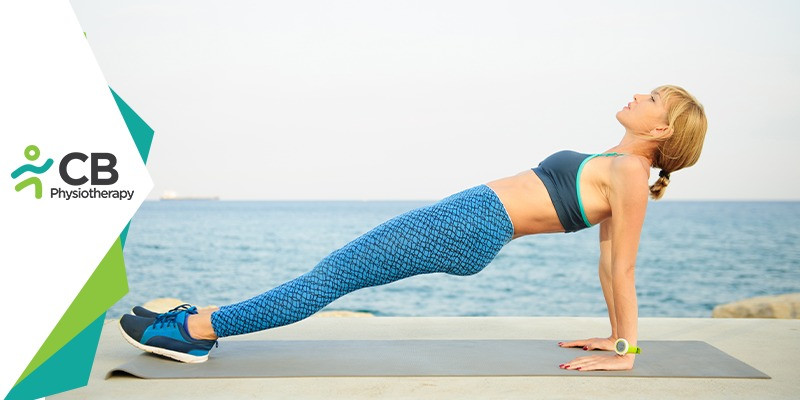Whether you are playing in the field or doing some workouts, your body requires equilibrium and stability. Stability is provided by the strong core muscles which ultimately help to stabilize the body, support the spine, and enhance overall fitness. The core muscles are also important for athletes, such as runners, because weak core muscles can lead to less endurance thus leading to injuries. Core stability is an important part of treatment for recovering from a back injury. It can be achieved by doing strengthening exercises prescribed by the physiotherapist. The physiotherapist can help in the recovery process or recommends a prevention program that improves the core stability and produces effective movement. In this blog, we will discuss the core stability and the exercises which can be done to strengthen these muscles.
Core Stability
The core is a group of muscles that move, rotate, and stabilize the spine. Core muscles help to withstand buckling from compressive forces and help to prevent shear and spin at each level of the vertebrae and pelvis. Core exercises strengthen the core muscles, abdominal muscles, and pelvic muscles. The response of these stabilizers depends upon the active system, passive system, and body control. These altogether contribute to spinal stability.
Active System
An active system is a group of small muscles that contribute to the development of spine control. Erector spinae, rectus abdominis, internal and external obliques, transverse abdominis, and multifidus are the core muscles that control the stiffness and position of spinal segments with one another. These muscles work during the movement to maintain balance. Dysfunction occurs when these muscles are inhibited causing decreased strength, endurance, and increased movement of spinal segments.
Passive System
The passive system includes ligaments, intervertebral discs, and skeletal structures that limit the movement of the spine. If the passive system is injured then the other components should be strengthened.
Control System
The Control system includes the nervous system. The nervous system controls and moves the spine and also maintains stability and plans the responses.
Exercises to Strengthen the core muscles:
Core-strengthening exercises can be performed on a carpeted floor or mat. Start each exercise by deep breathing.
Bridging:
· Lie on the back. Place the feet on the floor at hip-width apart and bend the knees. Place the hands at the sides with palms down.
· Tighten the core and glutes.
· Raise the hips to knee level and in line with the shoulders.
· Hold this position for 10–30 seconds.
Crunches:
· Lie on the back. Place the feet on the floor at hip-width apart and bend the knees. Keep the head and spine in one line. Cross the arms across the chest.
· Tighten the core and relax both the neck and shoulders. Tuck in the chin and lift the upper back, keeping the lower back and feet on the floor.
· Slowly lower the upper back and return to the starting position.
· Repeat 8–12 times.
Plank:
· Place hands below the shoulders and knees below the hips taking the bodyweight on hands and knees.
· Straighten the legs behind, keeping the feet hip-width apart, and tighten the core.
· Hold this position for 10–30 seconds.
Side plank with rotation:
· Lie on the right side with the right forearm below the shoulder. With the legs extended put the left foot on top of the right foot and then tighten the core.
· Form a straight line with the body. Raise the left arm straight up.
· Rotate the torso toward the floor and bring the left arm under the body.
· Rotate the torso and straighten the left arm to return to the starting position.
· Repeat 8–12 times.
· Repeat on the other side.
Bicycle crunch:
· Lie on the back. Place the feet on the floor at hip-width apart and bend the knees. Keep the head and spine in one line. Place the hands behind the head with elbows pointing out to the sides.
· Tighten the core muscles, moving the shoulders back and down. Bend the right knee toward the chest and extend the left leg.
· Lift the left shoulder and upper back, bringing the left elbow toward the right knee.
· Continue alternately with elbows and knees, repeat 8–12 times.
Dead bug:
· Lie on the back and push the stomach into the floor to close the gap under the back
· Push the stomach into the floor to close the gap under the back.
· Extend one arm and leg out of the body.
· Bring the arm and leg back to the middle and repeat on the other side.
Flutter kicks:
· Lie on the back extend the legs, toes pointed, and hands under the glutes to support the lower back.
· Lift both legs from the floor a few inches high and alternately kick the legs up and down.
Russian twists:
· Sit on the floor with bent knees.
· Hold the arms extended in front of the chest with palms down. Lean back so that the torso is at a 45-degree angle with the floor.
· Twist to the right as far as you can, then reverse the movement, and then twist to the left.
Hollow body hold:
· Start by lying flat on the back and then gently lift the legs off the floor while elevating the upper back and shoulders, hollowing the body out.
· Hold for approx 20 to 30 seconds.
Hollow body hang:
· Hang from a bar with gravity working against the legs and the core muscles are in a slightly different position.
· Hanging from a bar with the shoulders overhead promotes stability and mobility for both shoulder and core muscles.
Core strengthening helps to maintain a proper posture and a healthy spine, therefore makes it easier for an individual to perform the daily activities thus providing an overall sense of well-being.

